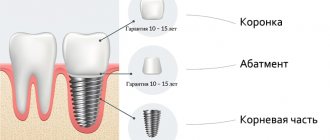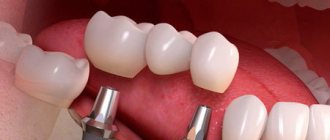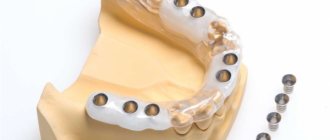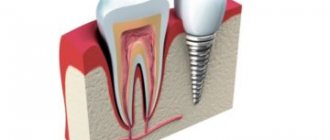Most popular technologies
Throughout the history of the use of implants, practical results have determined the most successful and durable dental implant technologies. The best results were shown by dismountable titanium oxidized implants, root-shaped, which were installed in the alveolar process of the jaw, successfully underwent osseointegration, followed by prosthetics with a ceramic crown.
The most popular and successful methods of dental implantation are two-stage classical implant installation, one-stage dental implantation, one-stage dental implantation, as well as transgingival dental implantation using a navigation surgical template.
What is turnkey dental implantation in Moscow?
Complex dental implantation in Moscow is offered to patients by the best clinics that offer services for fixing dental implants and subsequent installation of dentures.
If you are interested in full dental implantation, its price in Moscow is fixed taking into account the individual situation.
For example, in some cases, dental systems can be installed after tooth extraction, and a certain time must pass before the dentures are fixed. In some situations, installation of implants can take several months.
In our dentistry, the time for implantation is reduced to 4-8 weeks, which is due to the use of systems from premium manufacturers, the high professionalism of doctors and the use of modern dental technology.
Read more about turnkey dental implantation »
Features of two-stage (classical) technology
This technology has been used since the very beginning of modern dental implantation (since the 1950s) and is used in cases where other methods of installing implants are impossible, with traumatic removal, heavy smoking, less than ideal oral hygiene, and decreased mineralization and bone density. .
The implantation scheme looks like this:
At the first (surgical) stage,
- Gum incision, flap removal
- Installation of the implant into a prepared and calibrated socket
- Suturing flaps
After 3 or 6 months, depending on which jaw the operation was performed on, the second (prosthetic) stage is performed.
- The gum former is installed
- Taking impressions of teeth
- An abutment and a temporary acrylic crown are installed into the implant
- After 2 weeks, replace the temporary acrylic crown with a permanent ceramic, zirconium or metal-ceramic crown.
In total, everything takes from 4 to 8 months.
Features of one-stage dental implantation
With one-stage dental implantation technology, it is possible to partially combine the surgical and prosthetic stages, which are completely separated in two-stage classical implantation.
If there are conditions for this type of implantation (good density and mineralization of bone tissue, the possibility of good primary stabilization of the implant, good oral hygiene, absence of smoking), installation of the implant is accompanied by immediate prosthetics of this implant with a temporary plastic abutment and a temporary acrylic crown.
Prosthetics with a permanent crown are carried out after osseointegration in 3-6 months. One-stage dental implantation technology is used in the smile area and eliminates the need to install a gum former. Such rehabilitation allows the patient to leave after surgery immediately with crowns installed, albeit temporary, but crowns.
Reviews about dental implantation in Moscow
In general, patients leave positive dental implantation in Moscow . However, to get an impeccable result with a long-term guarantee, it is better to focus on implantation systems from leading manufacturers. This will shorten the period of implantation of the structure, ensure good initial stabilization, obtain excellent aesthetic and functional characteristics, and also eliminate the likelihood of inflammatory processes and peri-implantitis.
As stated earlier, we use only the best dental systems from Straumann and Nobel in the implantation process, which guarantees impeccable aesthetics along with the ability to withstand increased loads, excellent biocompatibility and a long service life.
Article Expert:
Dental implantation using a 3-D surgical template
One of the remarkable methods that implant surgeons have developed and successfully use in modern dental implantation is navigational dental implantation using surgical positioning templates. The essence of the technology is that, based on a CT scan of the patient, on a 3-D computer model of the jaw, the implantologist and orthopedic dentist place future implants, taking into account the volume of bone tissue and the location of large nerve trunks and vessels in the jaw.
Also, during virtual placement, the future occlusal (chewing) load on future crowns that will be installed in the implants, angles and vectors of loads on the intraosseous parts of the implants are taken into account.
After such planning, a lithographic model of plastic jaws is created using a computer tomogram, which is a complete copy of the patient’s real jaw. Taking into account preliminary planning, a plastic onlay is created - a basis (navigation surgical template) for the area of the jaw where the installation of implants is planned. Metal bushings are mounted into the base of the template, which provide and limit the direction and depth of drilling of the jaw bone tissue. Thus, the surgeon receives the specified depth and direction of the primary drilling of the bone tissue when installing implants in the jawbone.
This method ensures precise implantation taking into account the planned loads on the implants. Optimal conditions for implantation using this technology reduce the risk of subsequent implant rejection from subsequent occlusal (chewing) overloads during further operation of the implants.
Technology of dental implantation using a surgical template
USKRC
American Kidney Research Corporation (USKRC) recently announced the development of what they claim is the "world's first" implantable artificial kidney. This device uses a method to produce synthetic urine using deionization blood purification technology, which is the first of its kind. It involves filtration and ion transport processes that are similar to those occurring in the human kidney.
The development, which is funded by the USKRC, is led by scientists from the University of California, Los Angeles and the University of Arkansas.
According to the system developers,
There are various ions and substances in the blood, including sodium, potassium, urea and water, that need to be transported, either into the blood or into the urinary stream, and in appropriate amounts over a period of time. To do this, it is necessary to create an ion transport system and a water transport system, which is what we did. This is why we were able to create synthetic urine.
The device includes a pair of electrodeionization units - one for potassium, since these levels are necessary to maintain the electrical activity of the heart, and the other for all other ions. It also has three other modules: ultrafiltration to retain blood cells and proteins in the body, nanofiltration to prevent glucose release, and a reverse osmosis module to modulate the amount of water released.
The system is designed to remove urine at a rate comparable to that of a healthy kidney, dispensing approximately the same amount of water consumed in a given day. It includes feedback sensors and custom software to monitor changes in blood chemistry.
Standard dialysis machines expose blood to dialysate through a membrane; the difference between the composition of the dialysate and the blood determines which ions leave the body and enter the dialysate. Unlike dialysis, this approach does not require purified water or dialysate, which complicate the work of doctors and the lives of patients.
Recently, a prototype of such a device was tested on animals, including pigs, whose kidney function is very similar to the functioning of this organ in humans.
Test results showed that the technology could measure (and likely in the future monitor) the level of potassium removed from the blood and then transferred into artificial urine under computer control. The current prototype of this device is a wearable device the size of a small suitcase, which in the near future is expected to be improved, significantly smaller, and biocompatible to enable its implantation into the human body.
The USKRC estimates that if sufficient funding is secured, human trials could be initiated in two to two and a half years.
The reason this technology is a game-changer, the developers say, is its ability to purify the blood of patients with end-stage renal disease without the need for dialysis procedures. This changes the methodology that has been practiced for decades, resulting in a paradigm shift.
In the near future, the developers plan to refine each of the components of their device. He intends to change the ultrafilter so that the patient does not need heparin or an anticoagulant. In addition, they plan to redesign the ultrafilter so that the filter itself contains components that will prevent blood clotting and improve electrodeionization units.
Dental implantation surgery, technology
The implantation procedure itself goes like this:
- After a preliminary examination of the patient and diagnosis, a treatment plan and financial details of the treatment are drawn up.
- The day of the operation is set.
- On the day of implantation, premedication is carried out before the operation (the patient takes pills or an intramuscular injection is given).
- Then anesthesia and/or sedation is performed.
- The implantation operation itself begins, which lasts from 30 minutes to 4-6 hours, depending on the number of implants and the simultaneous bone grafting or sinus lift.
- After the operation is completed, a targeted or panoramic X-ray is taken, the patient is removed from sedation, if any, he is prescribed antibacterial and anti-inflammatory therapy, and is scheduled for examination 2-3 days after the operation.
- The patient is instructed about oral hygiene. If stitches were applied, they are removed 2-3 weeks after surgery.
New methods of dental implantation
There are several methods of implantation, both traditional and new, which very quickly help restore entire teeth on both jaws, while there is no need to restore implants for each tooth.
Medicine is actively developing all over the world, dentistry in particular. Some implantation methods are already outdated and practically not used:
- intramucosal;
- transosseous;
- subperiosteal.
Endodontic and plate implants are no longer used, and anesthesia completely eliminates discomfort during surgery. New modern implantation methods significantly reduce the period of preparation and implementation of the procedure, and the period of healing of soft tissues and implantation will not be painful, as it was before.
“All on four” implantation technique
This dental implantation technique was developed by the Portuguese doctor Malo in the 80s after extensive testing and analytical work.
It is quite simple and effective, based on traditional implantation, which existed before; in our time, the technique has been improved by new technologies. The essence of the method is as follows: four implants are implanted , then an artificial jaw is placed on them. It all happens this way:
- The doctor selects the implantation sites very carefully in order to distribute the pressure during chewing.
- Mostly, 2 anterior implants are placed and 2 at the location of five teeth.
- Implants are inserted at a 45-degree angle.
- This placement allows for the placement of long implants that do not penetrate the area of the maxillary sinuses, although they are placed next to them.
- Crowns are placed on the implants by screwing, which reduces the pressure on the teeth along with the crowns.
- If the jaw bone is short, then implants are implanted in 6 areas, which distributes the pressure even more evenly.
The “All on Four” implantation method will be effective if the jawbone cannot be built up due to long-term wearing of removable structures and the age of the patient. However, it also has its contraindications:
- Diabetes first degree.
- Poor blood clotting.
- Diseases of connective tissue and mucous membranes.
- Malignant formations.
- Immunopathological provisions.
This type of implantation significantly improves a person’s appearance , not only the teeth, but also the shape of the face. If there are no teeth at all, then wrinkles appear around the mouth and hollows of the cheeks. The new implantation method has the following advantages:
- restores the natural appearance of the face and gives it youth and volume;
- the feeling of natural teeth rather than the palate of dentures;
- a person can smile widely without being embarrassed by his appearance.
Features of laser implantation
One of the new methods of dental implantation is the installation of structures without the need to cut the gum. This method is also called express implantation .
Instead of an incision, piercing is preferably practiced in order to gain access to the jaw bone tissue. The doctor will not need to cut into the soft gum tissue, fold back the flap, and apply stitches at the end of the process. All this happens thanks to the use of new technologies in dentistry, for example, drills for penetration into soft tissues and lasers.
Laser implantation is the least traumatic and bloodless way of working:
- There is no need to apply sutures, since the cut tissues are quickly cauterized.
- The laser has an antiseptic effect.
- Healing is fast.
However, using a laser is not always as safe as it may seem. Not all dentists are unambiguous about this method. The reasons for this are:
- The laser, like a scalpel, has limited functionality and is used for gum resection, then drills are used. Not in all cases does a laser protect against infection. Basically it has a disinfecting effect.
- When using the laser, there will be a smell of burning skin.
- The survival rate of a tooth, according to some experts, does not depend on the instrument used; it all depends on the shape of the implant, the material and the length of the artificial root, which must be selected taking into account the special bone of the lower and upper jaw.
- Anesthesia is prescribed both when using a laser and a scalpel.
- In both cases, the operation time is approximately the same.
- The cost of laser implantation will be slightly higher than using a scalpel.
With laser implantation, the installation of one structure will last about 15 minutes, the survival rate increases, but due to the absence of stitches, there is practically no risk of inflammation of nearby soft tissues.
Types of implants and features of their choice
Each dental implant differs from each other depending on the manufacturer and its design. Private dental clinics mainly work with the following foreign brands:
- Xive.
- Nobel Biocare.
- Straumann.
- Implantium.
- Astra Tech.
- Alpha Bio.
The cost depends on the manufacturer of the product. In Russia, one implant costs an average of 15 thousand rubles, including the doctor’s work. The cost of a crown depends on the material:
- metal ceramics cost starting from 10 thousand rubles;
- zirconium dioxide crown – from 20 thousand rubles and above;
- metal-ceramic, equipped with gold plating - 55 thousand and above;
- metal-plastic - from 25 thousand rubles.
According to their shape, implants are divided into the following:
- Subperiosteal - they are used if there is little bone matter in the jaw. Titanium substitutes cannot be placed due to insufficient jaw height and width. The structures themselves are placed on artificial bone, and there is no need to build up teeth.
- Root-shaped - suitable for those who do not have problems with bone fragility. This type of structure is very similar to a real tooth. They come in screw and cylindrical types. In the first case, they are attached directly to the bone, and in the second, engraftment is carried out thanks to the porous surface material.
- Lamellar – if the patient’s bone is strong, but not very wide for root-shaped implants, then lamellar structures should be used. They have a narrow stripe and an elongated one, which is commensurate with the size of the bone. After gum resection, an implant is placed in the area with bone, and a crown is placed six months later, during which time the foreign body adapts to the new environment.
- Intramucosal - these implants are made on the basis of two parts, the first of which is fixed on a removable prosthesis, and the second is installed in the oral mucosa. The insertion point is a hole in the gum made with a bur. The prosthesis is attached to the implant so that it can later be removed. Implants should be used if there are problems in the palatal structure, atrophy of the alveolar cord, and the thickness of the mucosa allows installation.
- Mini implants – they are suitable for those who have problems with the front teeth. Thanks to a titanium screw, such an implant is inserted quickly and painlessly.
The need for bone tissue growth
As a rule, even at the stage of diagnosis and drawing up a treatment plan, it becomes clear whether it is possible to do without bone tissue augmentation before dental implantation or not. If it is not possible to install implants without bone grafting, then under certain conditions it is possible to perform a single-stage sinus lift with the installation of implants or a bone block transplant with a single-stage implantation.
If there are no conditions for such options, then bone grafting is performed first and implantation is carried out after 4-6 months. Some type of bone grafting is necessary for 75% of patients before implant placement.
Technology for installing a dental implant using bone grafting for insufficient jaw bone volume
Basal implantation
If the patient’s teeth have insufficient bone tissue, we offer the basal method - a prosthetic option in which it is necessary to restore the chewing function of the teeth, but without the need to build up bone tissue. This method was developed so that patients undergoing implantation could avoid a lengthy and rather dangerous bone augmentation procedure. The method involves working with a T-shaped titanium implant. This essentially refers to plate implantation with a base plate.
Before the procedure of basal dental implantation, it is necessary to determine the condition of the gums; then professional oral hygiene is carried out, a special strengthening gel is applied to prevent caries under the crown, and only then a pin is inserted.
Dentures using the basal method are cheaper for patients, so this method may be the only option in difficult financial situations. The pin is installed into the deep layers of bone tissue, which is very traumatic and painful. When performing such implantation, our dentists take care of pain relief, for which local anesthesia is used. After sanitation, the implantologist advises effective pain relievers, which can be purchased at any pharmacy. Dental implantation is a complex, complex procedure in dentistry, and the doctor is obliged to notify the patient about all stages and possible side effects before he begins to prepare teeth.
Stages of basal implantation:
- Preparation for the procedure: it is important to assess the condition of the mucous and bone tissue of the teeth. If a tooth hurts or there are serious dental problems, sanitation and re-diagnosis, X-ray examination, and magnetic resonance imaging of the jaw are performed.
- An impression is made and a temporary crown is installed on the teeth prepared for the procedure. The structure is manufactured in the laboratory.
- Implantation. It is carried out so that the head of the implant is above the gum; it does not go under the mucous membrane, as, for example, with the two-stage method. The implant is implanted under local anesthesia.
The procedure lasts no more than an hour, brings minor discomfort, the teeth hurt for some time, but no harm is done to the mucous membrane.
It is irrational to use the basal method for a large defect; In addition, it has a number of contraindications, which the implantologist will first familiarize you with.
Disadvantages of the basal method:
- Due to the lack of visual control, the doctor’s work is seriously complicated: he does not see the bone tissue and performs all manipulations blindly. Under this condition, it is difficult to give any guarantees about the result.
- Serious contraindications: installation of a T-shaped pin is not possible if there are cysts, granuloma, poor oral hygiene, crooked teeth, when straightening or extraction is required.
- The presence of severe pain, swelling after basal implantation, bruising, inability to straighten the dentition, pregnancy. These are relative contraindications, after the disappearance of which sanitization can be carried out.
- If the implant is rejected, a T-shaped defect remains in the socket, so returning to its former aesthetics by reinstalling the implant becomes impossible. It is possible to restore the defect and install veneers or crowns only after long-term therapy and bone augmentation; this will not be a free recovery that will take a long time.
- There are few experienced doctors, so restoration is possible only in certain dental clinics where good implantologists work.
After resection, it takes a lot of time for the socket to heal, which has an impact on the choice of implantation method. With express prosthetics, there is no need to wait; the system is installed at the first visit. A preliminary examination, a panoramic x-ray of the bone, and an assessment of oral hygiene are carried out. If home hygiene procedures are not performed properly, it may take days or even weeks to restore aesthetics as plaque and tartar removal, oral sanitation, wedge-shaped defects, fluorosis and other abnormalities are eliminated.
Before the main therapy, you may need both home and office whitening methods, for which a special home mouth guard is used, a pencil, or the procedure is carried out with a mouth guard over several visits to the dentist.
Preparing for surgery
Before dental implantation, most patients need to prepare their mouth for this operation. Preparation for dental implantation involves removing sources of infection from the oral cavity, located in hard and soft tissues. This means that it is necessary to cure carious teeth, cysts and granulomas that appear on the roots of teeth during periodontitis, remove incurable tooth roots, relieve inflammation of the gums in diseases such as periodontitis and gingivitis, and of course, before surgery, hygienists remove dental plaque and tartar.
If there are a large number of sources of infection in the oral cavity, the possibility of rejection of installed implants increases.
How many implants are needed for prosthetics?
- For permanent prosthetics, in the absence of teeth, it is necessary to install from six to fourteen implants on each toothless jaw. This allows you to make a permanent bridge for each jaw.
- If, for various reasons, a patient is shown a removable denture supported by implants, then two to four implants are required for each edentulous jaw.
- If several teeth are missing in different jaws, it is ideal to install a number of implants equal to the number of missing teeth.
How to choose dental implants
The choice of implant depends on the specific clinical situation and dental implantation technology.
- If there is a sufficient volume of bone tissue and a two-stage method of implant installation, one type of implant is needed, and, say, with a one-stage or one-stage method, another type is needed.
- There are different options for implants for the method using a surgical template or for simultaneous sinus lifting with the installation of implants.
- The density and mineralization of bone tissue also plays an important role. For systemic osteoporosis, implants with a microporous surface of the intraosseous part are often used.
Of course, the choice of implant always remains with the surgeon and orthopedic dentist.
Caring for implants after surgery
Immediately after surgery, care for implants consists of the following procedures:
- Taking anti-inflammatory and antibacterial drugs prescribed by the dentist.
- Antiseptic treatment of the operating area using rinses and ointments, as prescribed by the surgeon.
- Eating soft, gentle food to protect against injury to the operating area in the oral cavity, as prescribed by the doctor.
- Regular inspection of the operating area by the dentist during postoperative examinations. After the procedure, you must follow all the specialist’s recommendations.
It is especially important to follow all these recommendations after immediate implantation.
Dental implantation: age restrictions
Age restrictions for dental implantation are as follows:
- It is not recommended to install dental implants for young people, boys before the age of 23, and girls before the age of 21. This is due to the growth of the bones of the facial skeleton, including the jaws.
- There are no age restrictions for elderly patients as such; there are only general health restrictions that apply to all patients.
- After the onset of menopause in women, the doctor must take into account changes in the density and mineralization of the bone tissue of the jaws in order to select the optimal methods of implantation and coating of the intraosseous part of the implants.
Kidney Project (University of California, San Francisco)
The most famous development in this area is carried out within the framework of the Kidney Project, which employs specialists from the University of California, San Francisco and Vanderbilt University (USA). They have developed an implant the size of a coffee cup that can perform the functions of a kidney and is a great solution for patients with chronic kidney disease. This small, surgically implanted device consists of a highly permeable filtration block and human kidney cells.
The filter component has micropores that can be individually shaped to perform specific tasks. These filters can be placed one after the other, each of which will perform a different filtering function. In total, the device contains fifteen such filters, placed one on top of the other. In between and around these filters are living kidney cells that perform functions that artificial components do not do well, including reabsorbing nutrients and getting rid of accumulated waste. Since such a hybrid biological device would be placed out of reach of the body's immune response, it would thus be protected from rejection by the human body.
Those. The device contains living cells and could theoretically not only filter blood, but also perform other important functions of a real kidney, such as releasing hormones to control blood pressure.
In addition to filters that separate various substances in the blood, the implant includes a “bioreactor” that processes the ultrafiltrate, extracts sugar and salts from it, which it returns to the blood. In this process, water is also reabsorbed back into the body, and the ultrafiltrate is converted into “urine”, which is sent to the bladder for removal from the body. These devices are housed in a durable housing, covered with a film of material that is safe for use inside our body. The implant is connected by tubes to nearby veins and the bladder.
The device is powered by the patient's blood pressure and does not require the use of external tubing or cables that are now associated with wearable artificial kidneys.
Purified blood is returned to the circulatory system through veins connected to the implant, and waste is transferred to the bladder through a corresponding tube. All elements through which blood passes are coated, which should prevent the formation of blood clots. In addition, the formation of blood clots is prevented by a specially designed blood flow pattern within the system.
According to the developers, the device will not perform all the functions of a human kidney. “But the goal is for it to perform critical functions and be a system that, once implanted, allows the patient to eat and drink freely, have mobility, better overall health, and, unlike a transplant, not require the use of immunosuppressive drugs,” say university scientists.
Note that patients must still take the hormonal supplements they use during dialysis procedures.
Testing of a working prototype is expected to take place in 2020.
Cost of dental implantation, prices for implants
The cost of implantation surgery depends on such parameters as:
- Qualification of doctors and dental technicians.
- The price segment in which the dental clinic operates.
- Depending on the type of implant and the implantation technique used.
- From the need for anesthesia during implantation.
- Concentration of medical institutions and the degree of competition for the provision of dental implantation services.
- The scope of upcoming dental treatment.
- Materials from which prosthetic implants will be made.
Prices for implants also depend on the increase in the number of doctors who have the necessary skills and equipment to perform high-quality work with implants. In Moscow, prices for turnkey implantation (implant + crown) start from 30-40 thousand rubles.
Implants made from new materials
Previously, classical technology used standard materials from which implants were made. There were several manufacturing companies, and they all used the same methods and raw materials.
Today, the number of companies fulfilling orders for implant dentists has increased significantly. In addition, the list of materials used in this area has expanded.
Modern dental implants are manufactured using new technologies that are aimed at:
- minimal damage to the jawbone;
- increasing the density of bone tissue adhesion to the implanted element;
- improvement of the shape of the face and bite after the procedure.
The main advantages of implantation using modern materials from which implants are made:
- The screw implanted into the bone tissue was able to be made more rough, which ensured the strength of the connection, which even leaves behind the characteristics of its own bone and dental structures. In addition, the material density of each implant can be calculated individually for the most appropriate resistance to the pressure exerted on the dentition in a specific location.
- The warranty period for finished materials has increased significantly: the minimum is 20 years, and some manufacturers guarantee lifetime use.
- Modern products have a much lower probability of loosening, which prolongs the service life compared to earlier implantology technologies.
- The client’s feeling when using implants made from modern materials is much more pleasant: the teeth feel like their own, and not like dentures.










